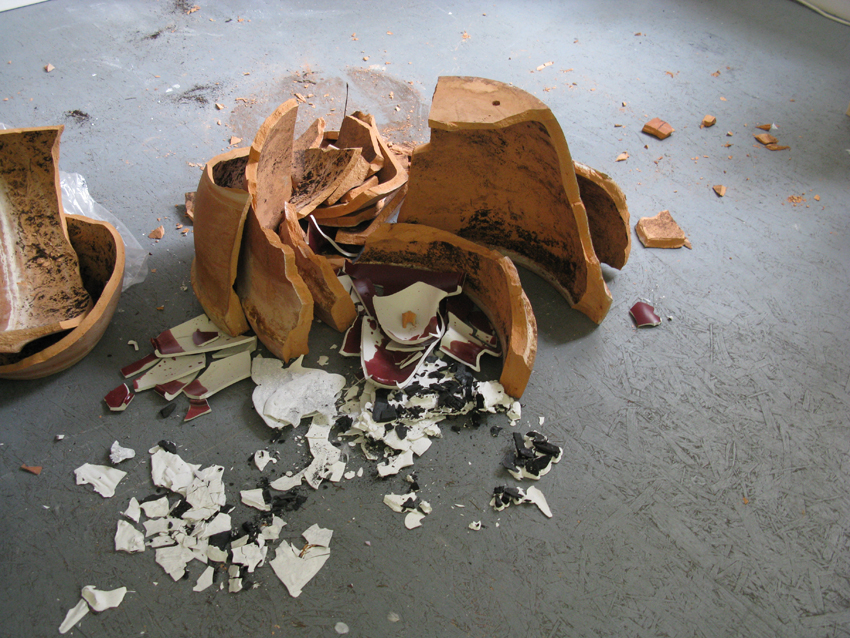Sonia Kacem – Dramaticule

In occasione della sua prima mostra personale presso T293 l’artista svizzero-tunisina Sonia Kacem presenta un’installazione site-specific che si articola in diverse parti rievocando le principali tematiche relative alla scultura e in particolare alla destrutturazione e decomposizione delle forme classiche.
Comunicato stampa
Italian text below
On the occasion of her first solo show at T293 the Swiss-Tunisian artist Sonia Kacem presents a site-specific installation in several volumes, evoking the fundamental issues related to sculpture and more specifically those of the dematerialization and the decomposition of classical forms.
Composed of clay sand, photographic paper backdrops and fragments of clay pots, the installation spreads along the lines to the vanishing point of the long corridor of the gallery. The mounds of dirt break up upon the flows of air and the passage of the audience, resembling a deserted plain; the “baroque” drape sags as gravity exerts its force; some sculptures made of photographic paper wither in a darkening process.
A time of latency results from the ensemble, opaque and indeterminate, and the installation, in the manner of a Beckettian Dramaticule, plays in a short time and in an atmosphere of post-catastrophe. Before being synonym for disaster, destruction or misery, the catastrophe, in the Greek theatre, was the last of the five parts of the tragedy and it represented the outcome solving a knot of antagonistic forces that blocked the theatrical action. It referred to that abrupt moment that turns a situation of tension or crisis into a state of final resolution, a happy or sad ending.
Besides, the fragments of clay pots seem to form the remains of a building that could be experienced by visiting an ancient city like Rome, characterised by a theatrical aesthetics where it seems drama is being performed at each corner. Fused with concrete roads, archaeological ruins complement the traces of ancient decor distinguished by obsolete monuments like the Pantheon. A collapsed column, snippets of a temple, a few scattered stones – archaeological remains that can be observed from an high or low angle, such as a freeze frame of an historical film.
A development that refers to the concept of territory as palimpsest, in which the multiple layers of urban organizations of the past draw the contemporary face of the city. An archaeology that can be read over and under the walls of the city, telling of an ancient and distant time towards which abstract and vague thoughts develop.
Sonia Kacem was born in Geneva in 1985 and studied at the Haute Ecole d’Art et de Design of Geneva.
In occasione della sua prima mostra personale presso T293 l’artista svizzero-tunisina Sonia Kacem presenta un’installazione site-specific che si articola in diverse parti rievocando le principali tematiche relative alla scultura e in particolare alla destrutturazione e decomposizione delle forme classiche.
Composta da terra rossa, fondali fotografici e frammenti di vasi in terracotta, l’installazione si dispiega nello spazio espositivo seguendo i punti di fuga del lungo corridoio della galleria. I cumuli di terra si modellano con le correnti d’aria e con il passaggio degli spettatori, rievocando pianure desertiche; il drappo “barocco” si piega a seconda della forza esercitata dalla gravità; alcune sculture di carta fotografica, impressionate dalla luce, si scuriscono gradualmente nel tempo.
Dall’insieme emerge un tempo di latenza, opaco e indeterminato e l’installazione, alla maniera beckettiana di un Dramaticule, si svolge in un breve periodo e in un’atmosfera di post-catastrofe. Prima di essere sinonimo di disastro, distruzione o miseria, la catastrofe, nel teatro greco, era l’ultima delle cinque parti della tragedia e rappresentava lo scioglimento del nodo creato dalle due forze antagoniste che bloccavano l’azione teatrale. Essa si riferisce a quel determinato momento in cui una situazione di tensione o di crisi è improvvisamente trasformata in uno stato di risoluzione finale, lieta o triste.
I frammenti dei vasi in terracotta sembrano inoltre formare le reliquie di un edificio di cui si può fare esperienza visitando un’antica città come Roma caratterizzata da un’estetica teatrale dove il dramma sembra realizzarsi in ogni angolo. Accanto a strade in cemento, rovine archeologiche completano uno scenario contraddistinto da monumenti antichi come il Panthéon. Una colonna crollata, frammenti di un tempio, pietre sparse – resti archeologici che possono essere osservati sia dall’alto che dal basso come in un “fermo immagine” di un vecchio film storico.
Un paesaggio che rimanda al concetto di territorio come palinsesto, in cui le molteplici stratificazioni urbane del passato delineano il volto moderno della città. Una storia archeologica che si può leggere sia sopra che sotto le mura della città, e che racconta di un tempo passato e lontano verso il quale si sviluppano astratti e sfuggenti pensieri.
Sonia Kacem è nata a Ginevra nel 1985 e ha studiato presso la Haute Ecole d’Art et de Design di Ginevra.



